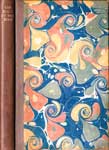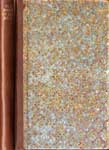Hope Mirrlees: Bibliography
The Book of the Bear: Being Twenty-one Tales newly translated
from the Russian by Jane Harrison and Hope Mirrlees
| SS Number | Description |
| Bear-A1 | First Printing 1926 |
DISCUSSION
Full Title:
The Book of the Bear: Being Twenty-one Tales newly translated from the Russian by Jane Harrison and Hope Mirrlees
Publication:
London, The Nonesuch Press, 1926.
Binding:
Bear-A1: 16mo, 6¼ in. x 4⅛ in. Quarter-bound with brown cloth spine, gilt lettering on spine only, marbled paper boards, all edges untrimmed and uncut. Spine: THE | BOOK | OF | THE | BEAR (see image above).
Bear-A1a: 16mo, 6¼ in. x 4⅛ in. Quarter-bound with brown cloth spine, gilt lettering on spine only, Japanese silver paper boards patterned with small flowers in gold, all edges untrimmed and uncut. Spine: THE | BOOK | OF | THE | BEAR (see image above).
I don't think there is any precedence between the two bindings. The Nonesuch Press is known to have issued a number of titles simultaneously in different bindings.
Notes:
The book is printed on a hard, very smooth art vellum. This seems to me to be an odd choice for an illustrated book, but Sir Francis knew more about paper and printing than I ever will, and the illustrations reproduced very well. The illustrator, Ray Garnett, and her husband, the writer David Garnett, were friends of HM. This was the only book Garnett illustrated for Nonesuch.
Some of the tales are traditional, while some are from classical Russian authors such as Pushkin and Tolstoy. Two of the stories were newly written for this volume by Alexey Michailovich Remizov. Mirrlees and Harrison met him in Paris and they became friends there. HM wrote an article praising Remizov's writing. It was reprinted in 2011, in Collected Poems, CP-A1, edited by Sandeep Parmar.
The book is dedicated "To the Great Bear." This was a joke between HM and Harrison - Jane had been given a teddy bear during the craze of the early 1900s, and the two ladies amused themselves by pretending to be his wives and conveying his instructions to each other. The first printings of Paris and HM's three novels each end with a drawing of Ursa major - the constellation of the Great Bear.




